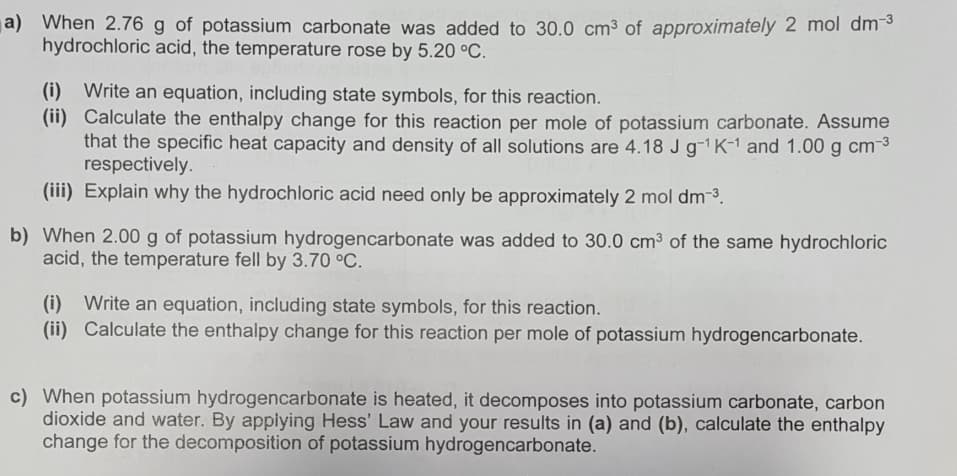Chemistry
10th Edition
ISBN:9781305957404
Author:Steven S. Zumdahl, Susan A. Zumdahl, Donald J. DeCoste
Publisher:Steven S. Zumdahl, Susan A. Zumdahl, Donald J. DeCoste
Chapter6: Thermochemistry
Section: Chapter Questions
Problem 68E: In a coffee-cup calorimeter, 1.60 g NH4NO3 is mixed with 75.0 g water at an initial temperature of...
Related questions
Question
Part b full solution please

Transcribed Image Text:a) When 2.76 g of potassium carbonate was added to 30.0 cm³ of approximately 2 mol dm-3
hydrochloric acid, the temperature rose by 5.20 °C.
(i) Write an equation, including state symbols, for this reaction.
(ii) Calculate the enthalpy change for this reaction per mole of potassium carbonate. Assume
that the specific heat capacity and density of all solutions are 4.18 J g-1K-1 and 1.00 g cm3
respectively.
(iii) Explain why the hydrochloric acid need only be approximately 2 mol dm-3.
b) When 2.00 g of potassium hydrogencarbonate was added to 30.0 cm3 of the same hydrochloric
acid, the temperature fell by 3.70 °C.
(i) Write an equation, including state symbols, for this reaction.
(ii) Calculate the enthalpy change for this reaction per mole of potassium hydrogencarbonate.
c) When potassium hydrogencarbonate is heated, it decomposes into potassium carbonate, carbon
dioxide and water. By applying Hess' Law and your results in (a) and (b), calculate the enthalpy
change for the decomposition of potassium hydrogencarbonate.
Expert Solution
This question has been solved!
Explore an expertly crafted, step-by-step solution for a thorough understanding of key concepts.
Step by step
Solved in 3 steps

Knowledge Booster
Learn more about
Need a deep-dive on the concept behind this application? Look no further. Learn more about this topic, chemistry and related others by exploring similar questions and additional content below.Recommended textbooks for you

Chemistry
Chemistry
ISBN:
9781305957404
Author:
Steven S. Zumdahl, Susan A. Zumdahl, Donald J. DeCoste
Publisher:
Cengage Learning


Chemistry: An Atoms First Approach
Chemistry
ISBN:
9781305079243
Author:
Steven S. Zumdahl, Susan A. Zumdahl
Publisher:
Cengage Learning

Chemistry
Chemistry
ISBN:
9781305957404
Author:
Steven S. Zumdahl, Susan A. Zumdahl, Donald J. DeCoste
Publisher:
Cengage Learning


Chemistry: An Atoms First Approach
Chemistry
ISBN:
9781305079243
Author:
Steven S. Zumdahl, Susan A. Zumdahl
Publisher:
Cengage Learning

Chemistry & Chemical Reactivity
Chemistry
ISBN:
9781337399074
Author:
John C. Kotz, Paul M. Treichel, John Townsend, David Treichel
Publisher:
Cengage Learning

Chemistry: Principles and Reactions
Chemistry
ISBN:
9781305079373
Author:
William L. Masterton, Cecile N. Hurley
Publisher:
Cengage Learning

Chemistry by OpenStax (2015-05-04)
Chemistry
ISBN:
9781938168390
Author:
Klaus Theopold, Richard H Langley, Paul Flowers, William R. Robinson, Mark Blaser
Publisher:
OpenStax